NVIDIA’s GeForce GTX 480 and GTX 470: 6 Months Late, Was It Worth the Wait?
by Ryan Smith on March 26, 2010 7:00 PM EST- Posted in
- GPUs
Temperature, Power, & Noise: Hot and Loud, but Not in the Good Way
For all of the gaming and compute performance data we have seen so far, we’ve only seen half of the story. With a 500mm2+ die and a TDP over 200W, there’s a second story to be told about the power, temperature, and noise characteristics of the GTX 400 series.

Starting with idle temperatures, we can quickly see some distinct events among our cards. The top of the chart is occupied solely by AMD’s Radeon 5000 series, whose small die and low idle power usage let these cards idle at very cool temperatures. It’s not until half-way down the chart that we find our first GTX 400 card, with the 470 at 46C. Truth be told we were expecting something a bit better out of it given that its 33W idle is only a few watts over the 5870 and has a fairly large cooler to work with. Farther down the chart is the GTX 480, which is in the over-50 club at 51C idle. This is where NVIDIA has to pay the piper on their die size – even the amazingly low idle clockspeed of 50MHz/core 101MHz/shader 67.5Mhz/RAM isn't enough to drop it any further.

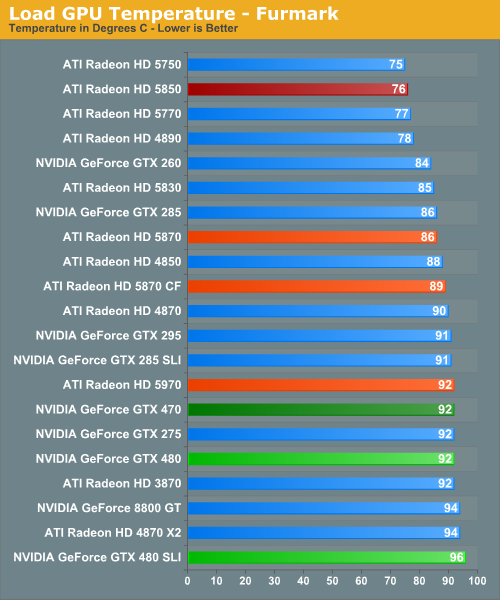
For our load temperatures, we have gone ahead and added Crysis to our temperature testing so that we can see both the worst-case temperatures of FurMark and a more normal gameplay temperature.
At this point the GTX 400 series is in a pretty exclusive club of hot cards – under Crysis the only other single-GPU card above 90C is the 3870, and the GTX 480 SLI is the hottest of any configuration we have tested. Even the dual-GPU cards don’t get quite this hot. In fact it’s quite interesting that unlike FurMark there’s quite a larger spread among card temperatures here, which only makes the GTX 400 series stand out more.
While we’re on the subject of temperatures, we should note that NVIDIA has changed the fan ramp-up behavior from the GTX 200 series. Rather than reacting immediately, the GTX 400 series fans have a ramp-up delay of a few seconds when responding to high temperatures, meaning you’ll actually see those cards get hotter than our sustained temperatures. This won’t have any significant impact on the card, but if you’re like us your eyes will pop out of your head at least once when you see a GTX 480 hitting 98C on FurMark.
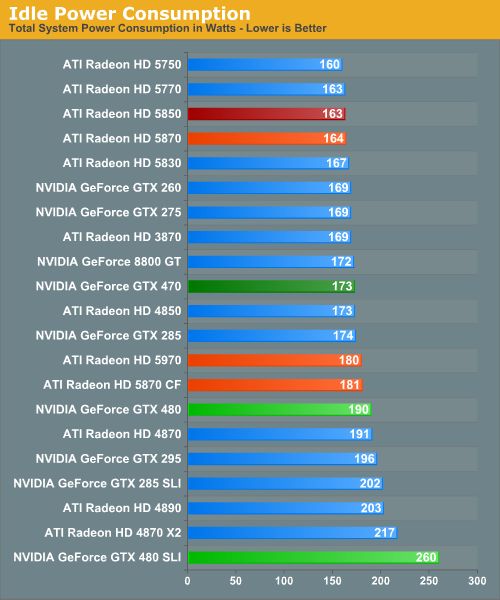
Up next is power consumption. As we’ve already discussed, the GTX 480 and GTX 470 have an idle power consumption of 47W and 33W respectively, putting them out of the running for the least power hungry of the high-end cards. Furthermore the 1200W PSU we switched to for this review has driven up our idle power load a bit, which serves to suppress some of the differences in idle power draw between cards.
With that said the GTX 200 series either does decently or poorly, depending on your point of view. The GTX 480 is below our poorly-idling Radeon 4000 series cards, but well above the 5000 series. Meanwhile the GTX 470 is in the middle of the pack, sharing space with most of the GTX 200 series. The lone outlier here is the GTX 480 SLI. AMD’s power saving mode for Crossfire cards means that the GTX 480 SLI is all alone at a total power draw of 260W when idle.
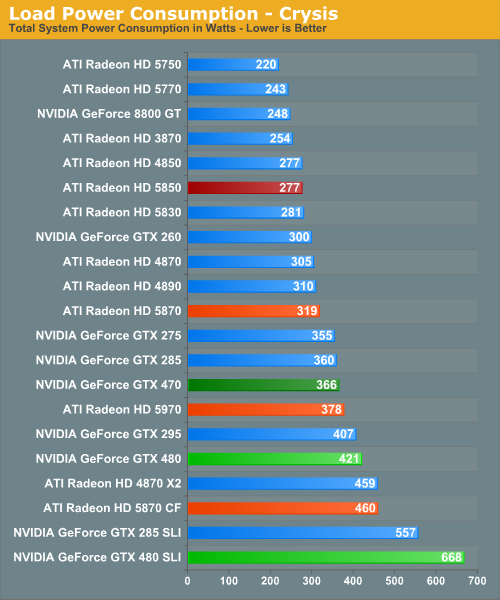
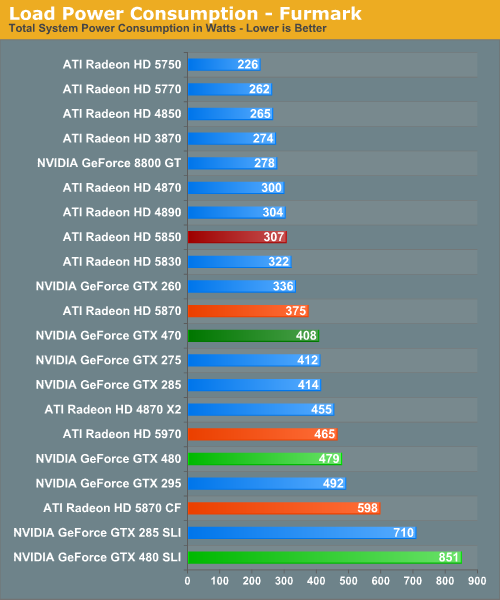
For load power we have Crysis and FurMark, the results of which are quite interesting. Under Crysis not only is the GTX 480 SLI the most demanding card setup as we would expect, but the GTX 480 itself isn’t too far behind. As a single-GPU card it pulls in more power than either the GTX 295 or the Radeon 5970, both of which are dual-GPU cards. Farther up the chart is the GTX 470, which is the 2nd most power draining of our single-GPU cards.
Under FurMark our results change ever so slightly. The GTX 480 manages to get under the GTX 295, while the GTX 470 falls in the middle of the GTX 200 series pack. A special mention goes out to the GTX 480 SLI here, which at 851W under load is the greatest power draw we have ever seen for a pair of GPUs.

Idle noise doesn’t contain any particular surprises since virtually every card can reduce its fan speed to near-silent levels and still stay cool enough. The GTX 400 series is within a few dB of our noise floor here.
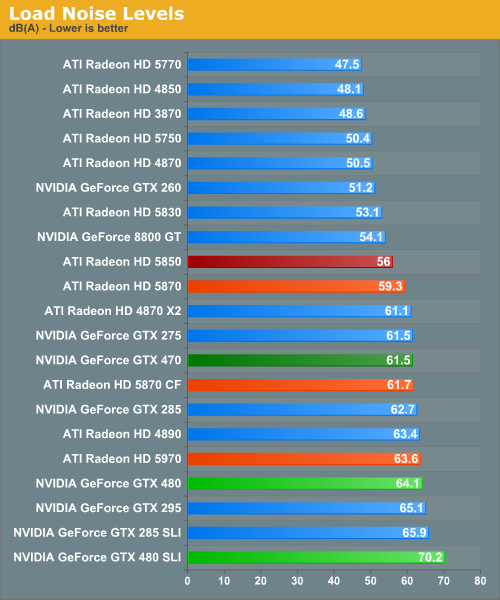
Hot, power hungry things are often loud things, and there are no disappointments here. At 70dB the GTX 480 SLI is the loudest card configuration we have ever tested, while at 64.1dB the GTX 480 is the loudest single-GPU card, beating out even our unreasonably loud 4890. Meanwhile the GTX 470 is in the middle of the pack at 61.5dB, coming in amidst some of our louder single-GPU cards and our dual-GPU cards.
Finally, with this data in hand we went to NVIDIA to ask about the longevity of their cards at these temperatures, as seeing the GTX 480 hitting 94C sustained in a game left us worried. In response NVIDIA told us that they have done significant testing of the cards at high temperatures to validate their longevity, and their models predict a lifetime of years even at temperatures approaching 105C (the throttle point for GF100). Furthermore as they note they have shipped other cards that run roughly this hot such as the GTX 295, and those cards have held up just fine.
At this point we don’t have any reason to doubt NVIDIA’s word on this matter, but with that said this wouldn’t discourage us from taking the appropriate precautions. Heat does impact longevity to some degree – we would strongly consider getting a lifetime warranty for the GTX 480 to hedge our bets.










196 Comments
View All Comments
Headfoot - Monday, March 29, 2010 - link
Unless you are an insider all of this "profitability" speculuation is just that, useless speculation.The reason they make both companies chips is more likely due to diversification, if one company does poorly one round then they are not going to go down with them. I'd hate to make ATI chips during the 2900XT era and i'd hate to make nVidia chips during the 5800 FX era
blindbox - Saturday, March 27, 2010 - link
I know this is going to take quite a bit of work, but can't you colour up the main cards and its competition in this review? By main cards, I mean GTX 470, 480 and 5850 and 5870. It's giving me a hard time to make comparison. I'm sure you guys did this before.. I think.It's funny how you guys only coloured the 480.
blindbox - Saturday, March 27, 2010 - link
I know this is going to take quite a bit of work, but can't you colour up the main cards and its competition in this review? By main cards, I mean GTX 470, 480 and 5850 and 5870. It's giving me a hard time to make comparison. I'm sure you guys did this before.. I think.It's funny how you guys only coloured the 480.
iwodo - Saturday, March 27, 2010 - link
If i remember correctly Nvidia makes nearly 30- 40% of their Profits from Telsa and Quadro. However Telsa and Quadro only occupies 10% of their Total GPU volume shipment. Or 20% if we only count desktop GPU.Which means Nvidia is selling those Perfect grade Fermi 512 Shader to the most profitable market. And they are just binning these chips to lower grade GTX 480 and GTX 470. While Fermi did not provide the explosion of HPC sales as we initially expected due to heat and power issues, but judging by pre-order numbers Nvidia still has quite a lot of orders to fulfill.
The Best thing is we get another Die Shrink in late 2010 / early 2011 to 28nm. ( It is actually ready for volume production in 3Q 2010 ). This should bring Lower Power and Heat. Hopefully the next update will get us a much better Memory Controller, with 256Bit controller and may be 6Ghz+ GDDR5 should offer enough bandwidth while getting better yield then 384Bit Controller.
Fermi may not be exciting now, but it will be in the future.
swing848 - Saturday, March 27, 2010 - link
We are not living in the future yet.When the future does arrive I expect there will also be newer, better hardware.
Sunburn74 - Saturday, March 27, 2010 - link
So how do you guys test temps? It's not specifically stated. Are you using a case? An open bench? Using readings from a temp meter? Or system readings from catalyst or nvidia control panel? Please enlighten. It's important because people will eventually have to extrapolate your results to their personal scenarios which involve cases of various designs. 94 degrees measured inside a case is completely different from 94 degrees measured on an open bench.Also, why are people saying all this stuff about switching sides and families? Just buy the best card available in your opinion. I mean it's not like ATI and Nvidia are feeding you guys and clothing your kids and paying your bills. They make gpus, something you plug into a case and forget about if it's working properly. I just don't get it :(
Ryan Smith - Saturday, March 27, 2010 - link
We're using a fully assembled and closed Thermaltake Spedo with a 120mm fan directing behind the video cards feeding them air. Temperatures are usually measured with GPU-Z unless for some reason it can't grab the temps from the driver.hybrid2d4x4 - Saturday, March 27, 2010 - link
Thanks for elaborating on the temps as I was wondering about that myself. One other thing I'd like to know is how the VRM and RAM temps are on these cards. I'm assuming that the reported values are for just the core.The reason I ask is that on my 4870 with aftermarket cooling and the fan set pretty low, my core always stayed well below 65, while the RAM went all the way up to 115 and VRMs up to ~100 (I have obviously increased fan speeds as the RAM temps were way too hot for my liking- they now peak at ~90)
Ryan Smith - Saturday, March 27, 2010 - link
Correct, it's just the core. We don't have VRM temp data for Fermi. I would have to see if the Everest guys know how to read it, once they add support.shiggz - Friday, March 26, 2010 - link
I just am not interested in a card with a TDP over 175W. When I upgraded from 8800gt to GTX 260 It was big jump in heat and noise and definitely at my tolerance limit during the summer months. I found myself under-clocking a card I had just bought.175W max though a 150W is preferred @ 250$ and I am ready to buy if NVIDIA wont make it then I will switch back to ATI.